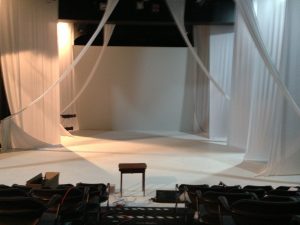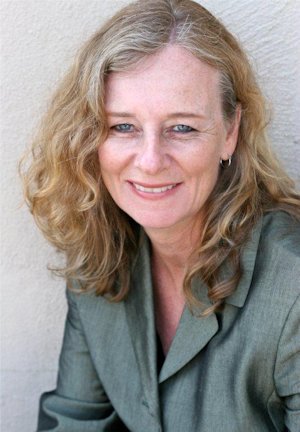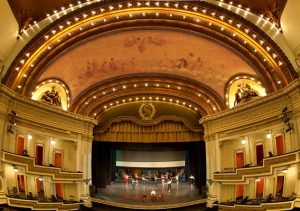Dance companies desperately seek performance space

The main theatre inside the 10th Avenue Theatre and Arts Centre is a popular alternative space for theater and dance troupes. Photo credit: Jeff Cotta
San Diego may be the country’s eighth largest city, but when it comes to dance venues, it’s a small town. Cash-strapped companies are desperate for space they can afford, amidst whispers of unfair rental fees and managers skimming ticket sales.
“It’s very tough,” says John Malashock of Malashock Dance. Like so many companies, he remembers better times.
“It was a tough blow, when the old Sushi space folded,” he says of Sushi Contemporary Performance and Visual Arts, which shut down in 2011 after 31 years of presenting cutting-edge shows. “It was flawed, but served the community well. We had a good run at the Old Globe as company in residence for about 12 years. We used Sherwood at the museum in La Jolla for a while. I heard that’s going away too.”
Malashock rented the Birch North Park Theatre for his troupe’s 25th anniversary in March, but because of its dysfunctional state of operations, he doubts the dance and theater community can risk using it now.
“I like the North Park, but there’s turmoil with ownership, bankruptcy with Lyric Opera,” Malashock says. “Issues with trusteeship have to be worked out before we can go back there.”
The Garfield Theatre has been a favorite among dance troupes, but that has shifted. Malashock reveals rent has doubled.
“That has to be resolved before Garfield can be an option again,” Malashock says. “And we enjoyed our time at the La Jolla Playhouse, as company in residence for Chagall, but I don’t have eyes on any theater right now.”
He is fond of historic spaces though, and has hope for the Luce Auditorium that sits vacant at Liberty Station, adjacent to his studio in Dance Place.
“The Luce could be our home theatre once it is renovated,” he says. “We need someone with an extra $15 or $20 million to make that happen. And the Spreckels is beautiful – the only place with a nice floor.”
[php snippet=1]
The Spreckels Theatre opened its doors in 1912. A century later, it’s the Cinderella story for City Ballet of San Diego.
“We scrambled for a long time,” said Jo Anne Emery, City’s managing director. “We danced on lawns, bought a portable sprung floor. We did the Garfield’s concrete stage with linoleum on top. We tried the Joan Kroc Theatre. Patrons didn’t like the site lines. We were desperate for a classical ballet venue.”
Once upon a time, there were dozens of elegant proscenium theaters in San Diego. Most have been demolished. The few that remain are too expensive, too big, or too “movie house.”
“The old Balboa and North Park are beautiful, but thrust stages aren’t deep enough,” Emery said. “We need four wings – choreographic tradition demands crossovers behind scenery. At the North Park, dancers ran down stairs, and back up a flight of stairs. At the Balboa, they had to go outside and around the back of the building! It was crazy!”
City Ballet found the perfect ballet venue when owner/operator Jacquelyn Littlefield said, “You have to make Spreckels your permanent home.”
“She [Ms. Littlefield] is loyal and generous” said Emery. “She attends with her family. Her support allows us to grow and perform shows like Carmina Burana with an orchestra and chorus. Patrons love the consistency.”
Ms. Littlefield’s “remarkable support is unheard of in the industry,” Emery says. Dance companies, including City Ballet, operate on the edge and have to be clever.
“I’ve rented nearly every theatre,” said Jean Isaacs of San Diego Dance Theater. Out of necessity, she created Trolley Dances, where riders view site-specific dances in unexpected places along the tracks. She helped build the White Box Theater adjacent to her studio at Dance Place, which fills a need for intimate programs and festivals.
The ultimate venue vagabond, Peter Kalivas of the PGK Dance Project purposely avoids traditional theaters.
“I choose businesses or odd places so I can pay my dancers, and there’s cross pollination, but you can’t just waltz in with ‘improv’,” he warns. “You have to be structured, get permission, liability insurance, and check out the electric system. You don’t want to blow fuses – you want that space and a new audience.”
Dance artists may have more options when they break genre boundaries and collaborate to rent venues, says Jeff Cotta, owner of the 10th Avenue Theatre.
“We have hard costs, like insurance, electric, and staffing, but I feel for dance companies,” Cotta says. “They put so much time into rehearsals and have short runs. We want to keep costs down and find common ground.”
The 10th Avenue hosted The Fringe Festival for seven full days in early July. Cotta wants to take a four-week chunk of time in the spring and reserve it for dance.
“I call it ‘Deca-Dance,” Cotta explains, “where four dance companies each take a week to get a reduced weekly rate, well below the usual cost. Eveoke and Visionary dance have been here. I want to create more opportunities for dance and be the dance-theater-center with the roof top and endless views.”
“Dance companies desperately seek performance space” also appears at http://artpulse.org.

Kris Eitland covers dance and theater for Sandiegostory.com and freelances for other publications, including the Union Tribune and Dance Teacher Magazine. She grew up performing many dance styles and continued intensive modern dance and choreography at the Univ. of Minnesota, Duluth, and San Diego State Univ. She also holds a journalism degree from SDSU. Her career includes stints in commercial and public radio news production.
Eitland has won numerous Excellence in Journalism awards for criticism and reporting from the San Diego Press Club. She has served on the Press Club board since 2011 and is a past president. She is a co-founder of Sandiegostory.com. She has a passion for the arts, throwing parties with dancing and singing, and cruising the Pacific in her family’s vintage trawler. She trains dogs, skis, and loves seasonal trips to her home state of Minnesota.


Great article on the “gypsy” tendencies of dance performances. Let’s hope the community rallies together to bring about a dance hub so we all can have a permanent performing space, all levels of dance makers can present. Special thanks goes to Jeff at 10th Avenue and Jean and the White Box Theater for opening their space to the growing number of independent artists looking to present work.